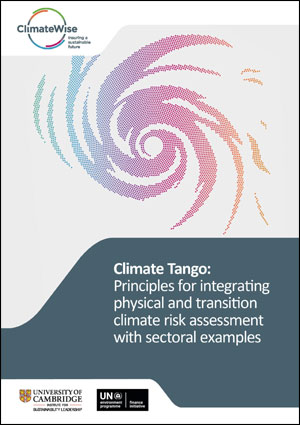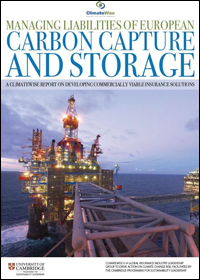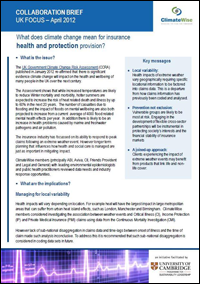Climate Tango: Principles for integrating physical and transition climate-risk assessment with sectoral examples.
As part of the UNEP FI TCFD programme, the report has developed theoretical principles and practical steps for implementation of an integrated assessment of physical and transition risks with examples of sectoral analysis. The research builds on the existing methodology and tools from the ClimateWise and the wider market, as well as workshops and interviews with financial practitioners.
The ClimateWise Transition Risk Framework
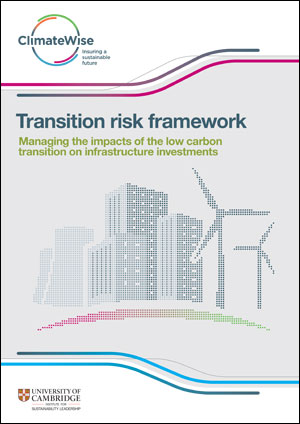 The ClimateWise Transition Risk Framework provides an open-source, step-by-step methodology on how to manage the risks and capture emerging opportunities from the low carbon transition. Transition risks include market and technological shifts, policy and legal changes and reputational damage. The framework is designed to help investors assess the breadth of asset types exposed to transition risk at portfolio level, define the potential financial impact of the low carbon transition down to asset level and incorporate transition impacts into asset financial models.
The ClimateWise Transition Risk Framework provides an open-source, step-by-step methodology on how to manage the risks and capture emerging opportunities from the low carbon transition. Transition risks include market and technological shifts, policy and legal changes and reputational damage. The framework is designed to help investors assess the breadth of asset types exposed to transition risk at portfolio level, define the potential financial impact of the low carbon transition down to asset level and incorporate transition impacts into asset financial models.
The ClimateWise Physical Risk Framework
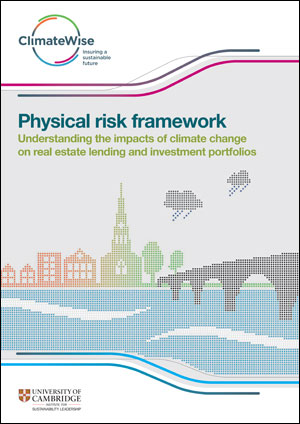 The ClimateWise Physical Risk Framework demonstrates how the expertise and tools of the insurance industry can support other parts of the financial system to understand their physical risk exposure. Physical risks include rising temperatures, flooding, drought, sea level rise and water scarcity, of which associated financial losses (both insured and uninsured) have significantly increased in recent years. The framework offers real estate investors and lenders a means of understanding the potential physical risks of climate change on their portfolios.
The ClimateWise Physical Risk Framework demonstrates how the expertise and tools of the insurance industry can support other parts of the financial system to understand their physical risk exposure. Physical risks include rising temperatures, flooding, drought, sea level rise and water scarcity, of which associated financial losses (both insured and uninsured) have significantly increased in recent years. The framework offers real estate investors and lenders a means of understanding the potential physical risks of climate change on their portfolios.
Resilient Cities (Phase I): Sustainable Cities (2013)
This study examined the importance of city adaptation to climate risk for wide variety of stakeholders, including the insurance sector. It highlights direct links between enhancing climate resilience and increased investor confidence. This leads to improved investor sentiment and sustainable growth, in turn creating a wealth of new opportunities for both cities and the insurance sector. The study introduces the concept of ‘resilience zones’. These are geographically bounded areas, within cities, that are particularly vulnerable to climate risk. By focusing redevelopment efforts on resilience zones helps cities to concentrate and prioritise the market conditions needed for promoting investment opportunities.
Resilient Cities (Phase II): Resilience Zones (2017)
Phase II of Resilient Cities further develops understandings of resilience zones. It explores how insurer expertise can support urban resilience by leveraging existing capabilities across the underwriting and asset management sides of their business. The study focuses on property development and infrastructure investment. This is because, by matching assets to liabilities, the insurance sector supports the efficient allocation of capital and the financing of assets underpinning the wider economy (e.g. infrastructure investments). Via long-term engagement between insurers and cities, this will help to diversify the financial system and manage the widening climate risk protection gap.
The City Innovation Platform (CIP) (2017)
One of the challenges facing insurers and investors, is that when underwriting emerging economy public infrastructure projects, the industry is often only involved towards the tail-end of the development process. This is ironic as the finance sector is often most exposed to project risks over the long term. Consequently, many infrastructure projects are unsustainable, uninsurable and fail to meet the needs of local communities. However, insurer expertise could support more informed infrastructural decision-making and planning. This project explores how emerging economy infrastructure projects can be redesigned, to integrate the finance sector more closely, from the start. It develops a methodology to support more bankable, insurable and sustainable infrastructure projects that meet the needs of local communities.
ENHANCE
The ENHANCE project, in which ClimateWise was involved, sought to address the role that Multi-Sector Partnerships (MSPs) between public, private and civil society stakeholders can play in sharing information and developing innovative solutions, to both prepare and respond to disasters, with an emphasis on the financial sector. MSPs build on growing awareness that the private sector – and especially the insurance industry – often has an inherent interest in reducing societal risk exposure. The ENHANCE project delivered a series of scientific and political findings at the EU, national and local levels and contributed to a number of new European and international policy frameworks. Outcomes ranged from the promotion of knowledge sharing through to direct policy recommendations on risk reduction measures.
Compendium of risk transfer initiatives in the developing world
The ClimateWise Compendium documented over 120 existing initiatives, across middle and lower income countries, involving the transfer of risk associated with natural hazards. The open source Compendium includes information on the types of schemes occurring, peril insured, involvement of public and private financing and where risk transfer is directly linked to risk reduction or supports adaptation.
Download the Compendium
Managing liabilities of European carbon capture and storage
This study identified ways to reduce the barriers to the successful roll out of CCS technology at scale across Europe, thereby paving the way for more effective action to prevent climate change.
Climate change and health
This collaboration highlighted ways to protect people from the health risks associated with climate change.
This draws on the fact that public health experts are increasingly demonstrating how mortality and morbidity is increasing from extreme weather events like heat waves and flooding.

